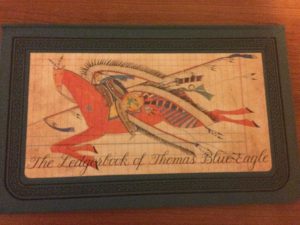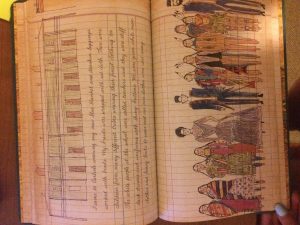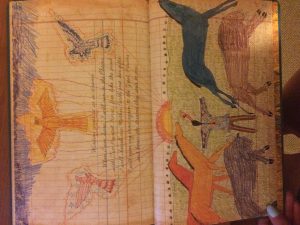The Ledgerbook of Thomas Blue Eagle
Written by Jewel Grutman and Gay Matthaei, illustrated by Adam Cvijanovic
Lickle Publishing, 1994
71 pages, Historical fiction
The Ledgerbook of Thomas Blue Eagle is the story of a young Lakota Sioux boy who describes his life with his tribe and his education at the Carlisle School to become more like a white man. The boy, called Blue Eagle because of his time living with a family of eagles following a battle with the Crow tribe, focuses his pre-Carlisle days with stories of his horse, Two Painted Horse, and the traditions of the Sioux, such as painting their stories on buffalo hides and playing ball games. Blue Eagle also focuses on the relationship that the Sioux had to the buffalo, especially how they used every part of the buffalo and only hunted what they needed. As the white men begin to take over the Sioux’s territory, they also begin to excessively kill the buffalo and kill many of the Sioux as well. A white soldier then talks to Blue Eagle’s father, Iron Arm, and convinces him to send Blue Eagle to the Carlisle School to learn the white man’s ways. Blue Eagle goes, and he is forced to give up his possessions, cut his hair, change his clothes, adopt a new name, and learn to read and write in English. By the time he finishes his schooling, Blue Eagle is now named Thomas and can read and write, but he is also aware that the white men do not respect the earth in the same way that the Native Americans do. Blue Eagle plans to return home to connect with his culture and respect his traditions.
For most children, this story is a window into the lives of Native Americans and the oppression that they faced at the hands of the white soldiers who destroyed their ways of life. Although this is a picture book, The Ledgerbook of Thomas Blue Eagle is not appropriate for young children because of the violence and oppression of the white men. However, this text has a lot of information about the lives of the Sioux and their traditions, as well as the atrocities committed by the settlers and soldiers and the oppression at the Carlisle School; since the text is so information-heavy, Ledgerbook would be appropriate for upper elementary, middle, or high school students. This story can also serve as a mirror for Sioux, or other Native American, students who might only see themselves represented in stories about the Pilgrims or in ways that undermine the horrible treatment of native people by European settlers.
The book is formatted to look like the fictional Thomas Blue Eagle wrote the text in cursive and drew the colored pencil illustrations in his ledgerbook while he was at, and eventually leaving, the Carlisle School. Instead of reading the book vertically, readers read horizontally, as the text and illustrations are not read left to right but rather up and down. The style is somewhat pictographic, which illustrator Cvijanovic drew in order to mirror other historical ledger drawings. The colors also add to the message of the text, as the Native Americans are often portrayed in vibrant colored clothing and the white men are often seen in one color, especially navy blue or red.
Grutman, Matthaei, and Cvijanovic are all white authors and illustrators who wrote this story of a young Sioux boy; however, the authors and illustrator did consult a Lakota artist, Arthur Amiotte/ Good Eagle Center, to make sure that their story was an accurate representation of life for the Lakota Sioux. The advising and the honest portrayal of the horrors of the invasion and assimilation make this book extremely important for learning about the ways that native people were treated in the United States.



